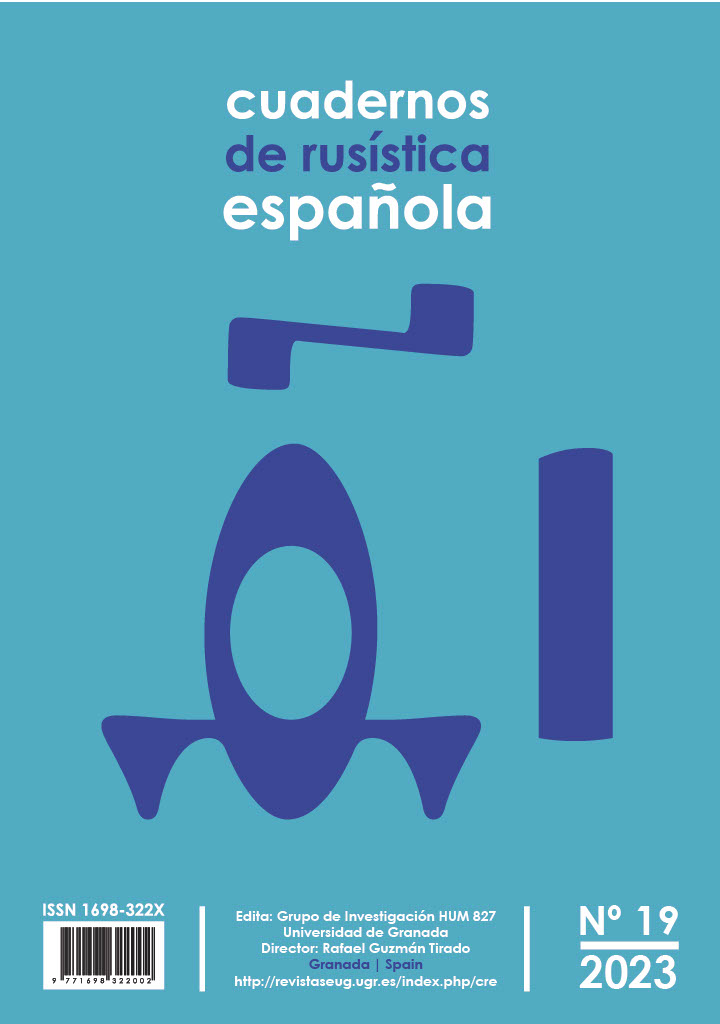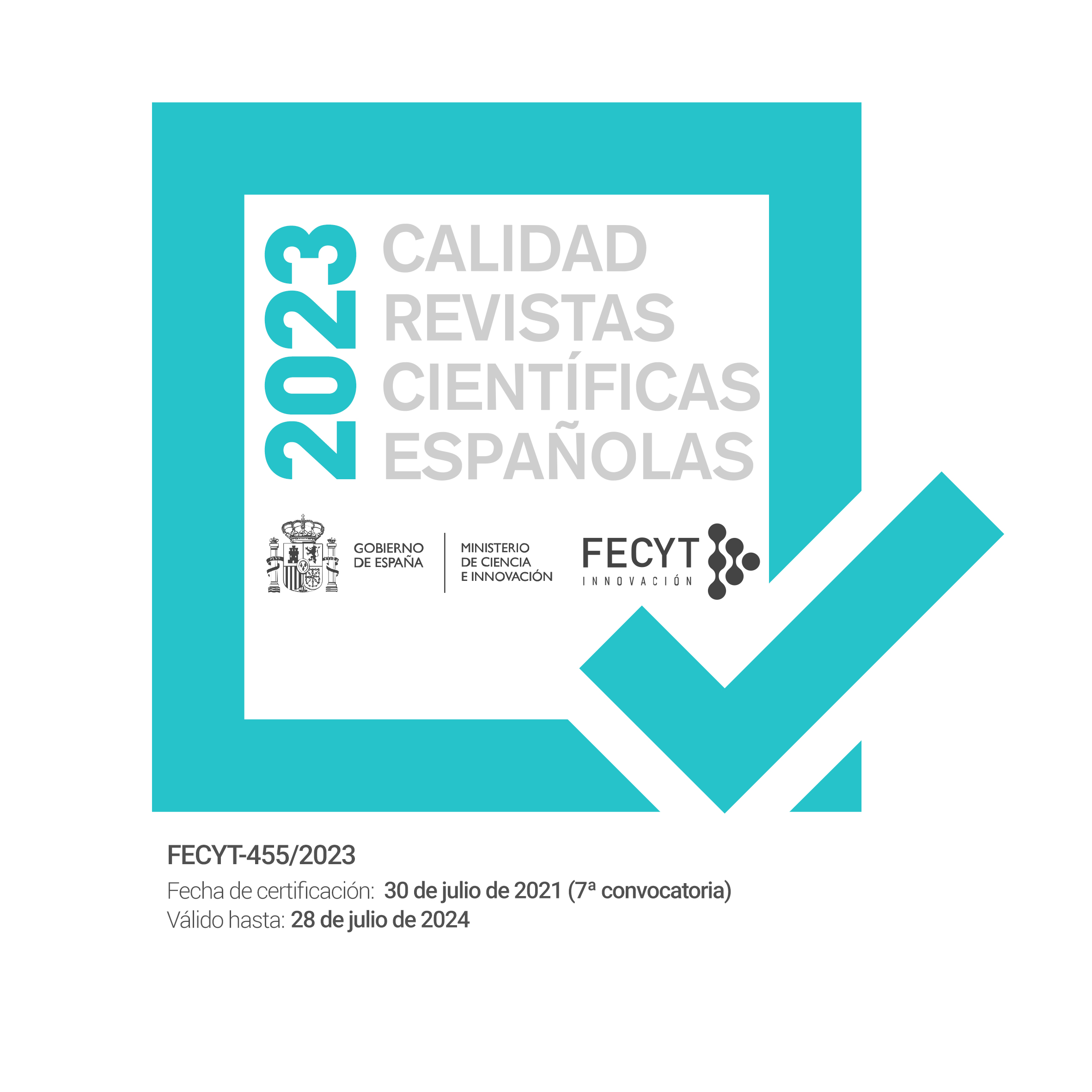Small Parametric Core of Russian and Spanish Vocabulary in the Linguocognitive Aspect
DOI:
https://doi.org/10.30827/cre.v19.27750Palabras clave:
Russian, Spanish, parametric analysis, lexical core, lexical picture of the world, cognitive-semantic blockResumen
The article presents a linguocognitive comparison of the core lexicon of the Russian and Spanish languages obtained by means of the quantitative analysis on the basis of linguistic parameters. The aim of the research is to reveal the cognitive-semantic basics of the lexical composition of the core in each language, to establish lexical-semantic parallels and differences, as well as to find out historical and cultural motivations for the active use of this lexicon in Russian and Spanish. For the analysis of lexical cores, the linguistic methods of cognitive language research have been used in combination with the comparative method, with the help of which it was possible to consider different ways of reflecting knowledge in the languages. As a result of the description, it has been revealed that the nuclear vocabulary in the languages under comparison builds the basic foundation of the linguistic pictures of the world of the Russian and Spanish languages where the correlation of common cognitive-semantic blocks prevails, which is due to the universal logic of the world perception. Various mental and linguistic approaches to the categorization of the same sphere of knowledge are also identified. Specific discrepancies are found within the blocks and are typical to a number of lexical units, which represent historical and cultural/ethno-cultural information.
Descargas
Citas
BABUSHKIN A.P. STERNIN I.A. (2018). Kogntivnaya lingvistika I semasiologia. Voronezh: Ritm.
BAGDASARIAN V.F. (2017). Sopostavitel’nyi kognitivnyi analiz leksiko-semanticheskih polei glagolov so znacheniem “otkrytie” I “sokrytie” v anglijskom, arm’anskom I russkom jazykakh. Vestnik RUDN. Seria Teoria iazyka. Semiotika.Semantika. T.8, № 4, s. 957—962.
BOTKIN V.P. (1976). Pis’ma ob Ispanii. Leningrad: Nauka.
DERBISHEVA Z.K. (2021). Ot parametricheskogo analiza leksiki k jazykovoj kartine mira. Vestnik Noskovskogo universiteta. Seria 19. Lingvistika I mazhkul’turnaja kommunikatsija. №1 ss.19-31.
ENTCIKLOPEDIA “VSEMIRNAJA ISTORIA”. Ispania v XIV — nachale XVI vv. Chast’ 4. Retrieved from: https://w.histrf.ru/articles/article/show/ispaniia_xiv_nach_xvi_v (date of application - 23.03.2022).
GLAZKOVA T.V. (2016). Obraz I rol’ otsa v russkoj kul’ture. Kul’tura kul’tury. Retrieved from: http://cult-cult.ru/archive-2016-2/ (date of application - 24.07. 2021).
GLINKINA L.A. (2011). Chastotnost’ kaak znachimyj registr leksikografii I frazeografii. Problemy istorii, fililogii, kul’tury. № 3(33), s.7-11.
JAKOVLEVA E.S. (1994). Fragmenty rysskoj jazykovoj kartiny mira (modeli prostanstva, vremrni I vosprijatija). Moskva.
КЕRSNOVSKIJ А.А. (2017). Istoria Russkoj armii. Dis... kand. filol. nauk. Retrieved from: https://www.dissercat.com/content/kognitivnoe-issledovanie-leksiko-semanticheskogo-polya-neuverennosti-v-angliiskom-yazyke-na- (date of application - 03.06.2022).
KHIMICH G. A. (2011). Kharakternye cherty ispanskoj kul’tury kak paradigma arhetipov natsional’nogo soznania. Vestnik RUDN. Seria Vseobshchaja istoria. № 2.
KRETOV A.A., VOIEVUDSKAJA O.M., MERKULOVA I.A., TITOV V.T. (2016). Edinstvo Evropy po dannym leksiki. Voronezh.
KRUGL’AKOVA V. (2010). Kontseptualizatsija vrashchenia v ispanskom I russkom jazykakh. Cuadernos de Rusística Española Nº 6, 29-54.
KUZNETSOV A.G. (2013). Romanskie jazyki: leksika, morfologia, zaimstvovania. Izdatel'stvo KRSU. Bishkek.
PROTSENKO I.Ju. (2012). Osobennosti leksiko-semanticheskoj gruppy “Reb’onok” v ispanskom I ukrainskom jazykakh. Cuadernos de Rusística Española nº 8, 137 – 148.
GUZMÁN TIRADO R. (2011). La semántica de los verbos que expresan “rotación”. Perspectiva tipológica (sobre el material del español y el ruso). Cuadernos de Rusística Española, Nº 7, 13-1.
STARODUBTSEVA Ju.A. (2018). Parametricheskoie jadro leksiki russkogo yazyka po dannym “Slovar’a russkogo jazyka v 4 tomakh” pod red. A.P. Jevgen’evoj . Avtoreferat disser. kand.filol.nauk. Boronezh.
TITOV V.T. (2002). Kvantitativnaja leksikologia ispanskogo jazyka. Vestnik Voronezhskogo gosudarstvennogo universiteta. Seria Lingvistika I mezhkul’turnaja kommunikatsia. № 3.
VODOVOZOVA E.N. (1896). Kak l’udi na belom svete zhivyt. Ispantsy. Sankt- Peterburg.
VSEMIRNAJA ISTORIA. ENTSIKLOPEDIA. (1958). V. 4. Retrieved from: http://historic.ru/books/item/f00/s00/z0000029/index.shtml (date of application - 15.01.2021).
ZHEZHEROVA V.P. (2006). Kognitivnoe issledovanie leksiko-semanticheskogo pol’a neuverennosti v angijskom jazyke: na materiale glagolov.












